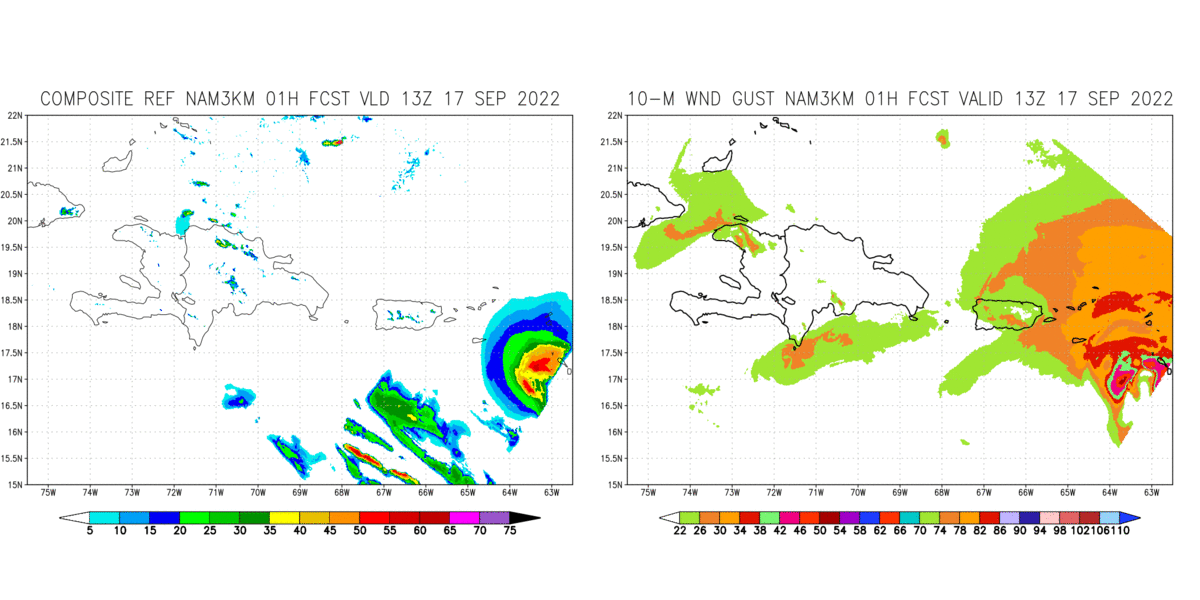North American Mesoscale

Above: NAM 3 km Puerto Rico nest forecast loop of composite radar reflectivity (left, dBz) and instantaneous 10-m wind gust (right, kts) initialized at 1200 UTC 17 September 2022, showing the passage of Hurricane Fiona through the domain.

The North American Mesoscale (NAM) is one of the forecast systems NCEP's Environmental Modeling Center has developed to provide mesoscale guidance to public and private sector meteorologists. It is run four times daily at 0000, 0600, 1200, and 1800 UTC and consists of the following components:
- The NOAA Environmental Modeling System (NEMS) version of the Non-Hydrostatic Multi-scale Model in B-grid (NMMB). The NAM run makes forecasts for the following domains in one execution of the production run:
- Full North American 12 km parent domain forecast to 84-h
- Four fixed 3-km nested domains forecasts to 60-h, which are all one-way nested inside the parent 12 km domain:
- CONUS
- Alaska
- Hawaii
- Puerto Rico
- One very high-resolution nest run to 36-h at 1.5 km horizontal resolution that is placed at different locations each cycle over the CONUS or Alaska. During the summer fire weather season the location of this nest is usually determined by the National Interagency Fire Center and is used primarily to provide high-resolution guidance to Incident Meteorologists (IMETS) who are dispatched to wildfire locations to support fire-fighting operations. During the rest of the year the location is set based on requests from the NCEP Service Centers, NWS Regions and NWS Forecast Offices.
The NAM nests run with the same physics suite as the NAM 12 km parent domain with the following exceptions:
-
The nests are not run with parameterized convection
-
The nests do not run with gravity wave drag/mountain blocking
-
In the Ferrier-Aligo microphysics, the 12 km domain's threshold RH for the onset of condensation is 98%, for the nests it is 100%
-
The NAM nests use a higher divergence damping coefficient.
-
The NAM nests advect each individual microphysics species separately; the NAM 12 km parent domain advects total condensate.
The NAM is initialized with a 6-h data assimilation (DA) cycle with hourly analysis updates using the NCEP hybrid variational ensemble analysis for the 12 km parent domain and the 3 km CONUS/Alaska nests. The non-cycled nests (Hawaii, Puerto Rico, Fire Weather) are initialized with a first guess from the 12 km parent domain.
The last major upgrade to the NAM was implemented in March 2017, as EMC has transitioned to devote its full resources towards the development of a high-resolution regional "standalone" version of the FV3 dynamic core with advanced physics for eventual inclusion in a high-resolution convective-allowing ensemble system. This high-resolution convective-allowing ensemble system will eventually replace all current NCEP mesoscale models in providing rapidly-updated mesoscale forecast guidance for the nation's weather enterprise.
Additional NAM Information
Comments, questions, suggestions? Contact Eric Rogers

Above: NAM 3 km Puerto Rico nest forecast loop of composite radar reflectivity (left, dBz) and instantaneous 10-m wind gust (right, kts) initialized at 1200 UTC 17 September 2022, showing the passage of Hurricane Fiona through the domain.

The North American Mesoscale (NAM) is one of the forecast systems NCEP's Environmental Modeling Center has developed to provide mesoscale guidance to public and private sector meteorologists. It is run four times daily at 0000, 0600, 1200, and 1800 UTC and consists of the following components:
- The NOAA Environmental Modeling System (NEMS) version of the Non-Hydrostatic Multi-scale Model in B-grid (NMMB). The NAM run makes forecasts for the following domains in one execution of the production run:
- Full North American 12 km parent domain forecast to 84-h
- Four fixed 3-km nested domains forecasts to 60-h, which are all one-way nested inside the parent 12 km domain:
- CONUS
- Alaska
- Hawaii
- Puerto Rico
- One very high-resolution nest run to 36-h at 1.5 km horizontal resolution that is placed at different locations each cycle over the CONUS or Alaska. During the summer fire weather season the location of this nest is usually determined by the National Interagency Fire Center and is used primarily to provide high-resolution guidance to Incident Meteorologists (IMETS) who are dispatched to wildfire locations to support fire-fighting operations. During the rest of the year the location is set based on requests from the NCEP Service Centers, NWS Regions and NWS Forecast Offices.
The NAM nests run with the same physics suite as the NAM 12 km parent domain with the following exceptions:
-
The nests are not run with parameterized convection
-
The nests do not run with gravity wave drag/mountain blocking
-
In the Ferrier-Aligo microphysics, the 12 km domain's threshold RH for the onset of condensation is 98%, for the nests it is 100%
-
The NAM nests use a higher divergence damping coefficient.
-
The NAM nests advect each individual microphysics species separately; the NAM 12 km parent domain advects total condensate.
The NAM is initialized with a 6-h data assimilation (DA) cycle with hourly analysis updates using the NCEP hybrid variational ensemble analysis for the 12 km parent domain and the 3 km CONUS/Alaska nests. The non-cycled nests (Hawaii, Puerto Rico, Fire Weather) are initialized with a first guess from the 12 km parent domain.
The last major upgrade to the NAM was implemented in March 2017, as EMC has transitioned to devote its full resources towards the development of a high-resolution regional "standalone" version of the FV3 dynamic core with advanced physics for eventual inclusion in a high-resolution convective-allowing ensemble system. This high-resolution convective-allowing ensemble system will eventually replace all current NCEP mesoscale models in providing rapidly-updated mesoscale forecast guidance for the nation's weather enterprise.
Additional NAM InformationComments, questions, suggestions? Contact Eric Rogers